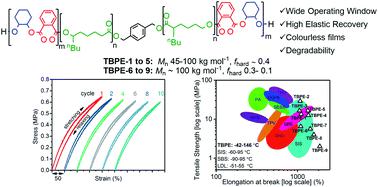当前位置:
X-MOL 学术
›
Chem. Sci.
›
论文详情
Our official English website, www.x-mol.net, welcomes your feedback! (Note: you will need to create a separate account there.)
Triblock polyester thermoplastic elastomers with semi-aromatic polymer end blocks by ring-opening copolymerization
Chemical Science ( IF 8.4 ) Pub Date : 2020-05-04 , DOI: 10.1039/d0sc00463d Georgina L. Gregory 1, 2, 3, 4 , Gregory S. Sulley 1, 2, 3, 4 , Leticia Peña Carrodeguas 1, 2, 3, 4 , Thomas T. D. Chen 1, 2, 3, 4 , Alba Santmarti 4, 5, 6, 7 , Nicholas J. Terrill 4, 8, 9, 10 , Koon-Yang Lee 4, 5, 6, 7 , Charlotte K. Williams 1, 2, 3, 4
Chemical Science ( IF 8.4 ) Pub Date : 2020-05-04 , DOI: 10.1039/d0sc00463d Georgina L. Gregory 1, 2, 3, 4 , Gregory S. Sulley 1, 2, 3, 4 , Leticia Peña Carrodeguas 1, 2, 3, 4 , Thomas T. D. Chen 1, 2, 3, 4 , Alba Santmarti 4, 5, 6, 7 , Nicholas J. Terrill 4, 8, 9, 10 , Koon-Yang Lee 4, 5, 6, 7 , Charlotte K. Williams 1, 2, 3, 4
Affiliation

|
Thermoplastic elastomers benefit from high elasticity and straightforward (re)processability; they are widely used across a multitude of sectors. Currently, the majority derive from oil, do not degrade or undergo chemical recycling. Here a new series of ABA triblock polyesters are synthesized and show high-performances as degradable thermoplastic elastomers; their composition is poly(cyclohexene-alt-phthalate)-b-poly(ε-decalactone)-b-poly(cyclohexene-alt-phthalate) {PE–PDL–PE}. The synthesis is accomplished using a zinc(II)/magnesium(II) catalyst, in a one-pot procedure where ε-decalactone ring-opening polymerization yielding dihydroxyl telechelic poly(ε-decalatone) (PDL, soft-block) occurs first and, then, addition of phthalic anhydride/cyclohexene oxide ring-opening copolymerization delivers semi-aromatic polyester (PE, hard-block) end-blocks. The block compositions are straightforward to control, from the initial monomer stoichiometry, and conversions are high (85–98%). Two series of polyesters are prepared: (1) TBPE-1 to TBPE-5 feature an equivalent hard-block volume fraction (fhard = 0.4) and variable molar masses 40–100 kg mol−1; (2) TBPE-5 to TBPE-9 feature equivalent molar masses (∼100 kg mol−1) and variable hard-block volume fractions (0.12 < fhard < 0.4). Polymers are characterized using spectroscopies, size-exclusion chromatography (SEC), thermal gravimetric analysis (TGA), differential scanning calorimetry (DSC) and dynamic mechanical thermal analysis (DMTA). They are amorphous, with two glass transition temperatures (∼−51 °C for PDL; +138 °C for PE), and block phase separation is confirmed using small angle X-ray scattering (SAXS). Tensile mechanical performances reveal thermoplastic elastomers (fhard < 0.4 and N > 1300) with linear stress–strain relationships, high ultimate tensile strengths (σb = 1–5 MPa), very high elongations at break (εb = 1000–1900%) and excellent elastic recoveries (98%). There is a wide operating temperature range (−51 to +138 °C), an operable processing temperature range (+100 to +200 °C) and excellent thermal stability (Td,5% ∼ 300 °C). The polymers are stable in aqueous environments, at room temperature, but are hydrolyzed upon gentle heating (60 °C) and treatment with an organic acid (para-toluene sulfonic acid) or a common lipase (Novozyme® 51032). The new block polyesters show significant potential as sustainable thermoplastic elastomers with better properties than well-known styrenic block copolymers or polylactide-derived elastomers. The straightforward synthesis allows for other commercially available and/or bio-derived lactones, epoxides and anhydrides to be developed in the future.
中文翻译:

具有半芳族聚合物端嵌段的三嵌段聚酯热塑性弹性体,通过开环共聚
热塑性弹性体得益于高弹性和直接(再)加工性;它们被广泛应用于众多领域。当前,大多数来自石油,不降解或不进行化学回收。此处合成了一系列新的ABA三嵌段聚酯,它们具有可降解的热塑性弹性体的高性能。它们的成分是聚(环己烯ALT -邻苯二甲酸酯) - b -聚(ε癸内酯) - b -聚(环己烯ALT -邻苯二甲酸酯){PE-PDL-PE}。使用锌(II)/镁(II)完成合成)催化剂,在一个一锅法中,首先发生ε-十内酯开环聚合反应,生成二羟基远螯聚(ε-癸烯酮)(PDL,软嵌段),然后加入邻苯二甲酸酐/环己烯氧化物开环共聚反应提供半芳香族聚酯(PE,硬嵌段)端嵌段。从最初的单体化学计量开始,嵌段的组成很容易控制,转化率很高(85-98%)。制备了两个系列的聚酯:(1)TBPE-1至TBPE-5具有等效的硬嵌段体积分数(f hard = 0.4)和40-100 kg mol -1的可变摩尔质量;(2)TBPE-5至TBPE-9具有当量摩尔质量(〜100 kg mol -1)和可变硬块体积分数(0.12 < f硬<0.4)。使用光谱学,尺寸排阻色谱(SEC),热重分析(TGA),差示扫描量热法(DSC)和动态机械热分析(DMTA)对聚合物进行表征。它们是无定形的,具有两个玻璃化转变温度(PDL为-51°C; PE为+138°C),并且通过小角度X射线散射(SAXS)确认了嵌段相分离。拉伸机械性能揭示了热塑性弹性体( ˚F硬<0.4和Ñ > 1300)与线性应力-应变关系,高的极限拉伸强度( σ b = 1-5兆帕),非常高的断裂伸长率( ε b= 1000–1900%)和优异的弹性回复率(98%)。有宽的工作温度范围(-51至+138°C),可操作的加工温度范围(+100至+200°C)和出色的热稳定性(T d,5%〜300°C)。的聚合物在含水环境中稳定,在室温下,但在温和加热(60℃)处理和用有机酸(水解段-甲苯磺酸)或普通脂肪酶(Novozyme®51032)。与众所周知的苯乙烯嵌段共聚物或聚丙交酯衍生的弹性体相比,这种新型的嵌段聚酯具有更好的性能,具有可持续发展的热塑性弹性体的巨大潜力。简单的合成方法允许将来开发其他可商购的和/或生物衍生的内酯,环氧化物和酸酐。
更新日期:2020-07-01
中文翻译:

具有半芳族聚合物端嵌段的三嵌段聚酯热塑性弹性体,通过开环共聚
热塑性弹性体得益于高弹性和直接(再)加工性;它们被广泛应用于众多领域。当前,大多数来自石油,不降解或不进行化学回收。此处合成了一系列新的ABA三嵌段聚酯,它们具有可降解的热塑性弹性体的高性能。它们的成分是聚(环己烯ALT -邻苯二甲酸酯) - b -聚(ε癸内酯) - b -聚(环己烯ALT -邻苯二甲酸酯){PE-PDL-PE}。使用锌(II)/镁(II)完成合成)催化剂,在一个一锅法中,首先发生ε-十内酯开环聚合反应,生成二羟基远螯聚(ε-癸烯酮)(PDL,软嵌段),然后加入邻苯二甲酸酐/环己烯氧化物开环共聚反应提供半芳香族聚酯(PE,硬嵌段)端嵌段。从最初的单体化学计量开始,嵌段的组成很容易控制,转化率很高(85-98%)。制备了两个系列的聚酯:(1)TBPE-1至TBPE-5具有等效的硬嵌段体积分数(f hard = 0.4)和40-100 kg mol -1的可变摩尔质量;(2)TBPE-5至TBPE-9具有当量摩尔质量(〜100 kg mol -1)和可变硬块体积分数(0.12 < f硬<0.4)。使用光谱学,尺寸排阻色谱(SEC),热重分析(TGA),差示扫描量热法(DSC)和动态机械热分析(DMTA)对聚合物进行表征。它们是无定形的,具有两个玻璃化转变温度(PDL为-51°C; PE为+138°C),并且通过小角度X射线散射(SAXS)确认了嵌段相分离。拉伸机械性能揭示了热塑性弹性体( ˚F硬<0.4和Ñ > 1300)与线性应力-应变关系,高的极限拉伸强度( σ b = 1-5兆帕),非常高的断裂伸长率( ε b= 1000–1900%)和优异的弹性回复率(98%)。有宽的工作温度范围(-51至+138°C),可操作的加工温度范围(+100至+200°C)和出色的热稳定性(T d,5%〜300°C)。的聚合物在含水环境中稳定,在室温下,但在温和加热(60℃)处理和用有机酸(水解段-甲苯磺酸)或普通脂肪酶(Novozyme®51032)。与众所周知的苯乙烯嵌段共聚物或聚丙交酯衍生的弹性体相比,这种新型的嵌段聚酯具有更好的性能,具有可持续发展的热塑性弹性体的巨大潜力。简单的合成方法允许将来开发其他可商购的和/或生物衍生的内酯,环氧化物和酸酐。



























 京公网安备 11010802027423号
京公网安备 11010802027423号